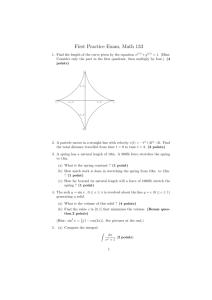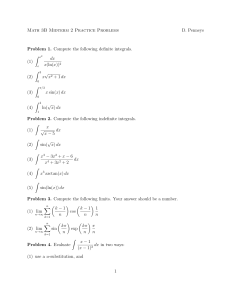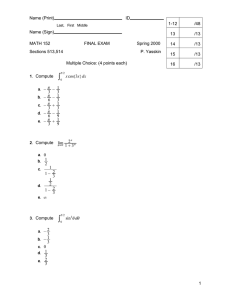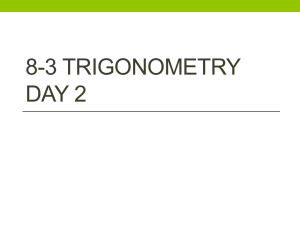Preparation Sheet for Final Math171, Fall 2015 General Comments
advertisement
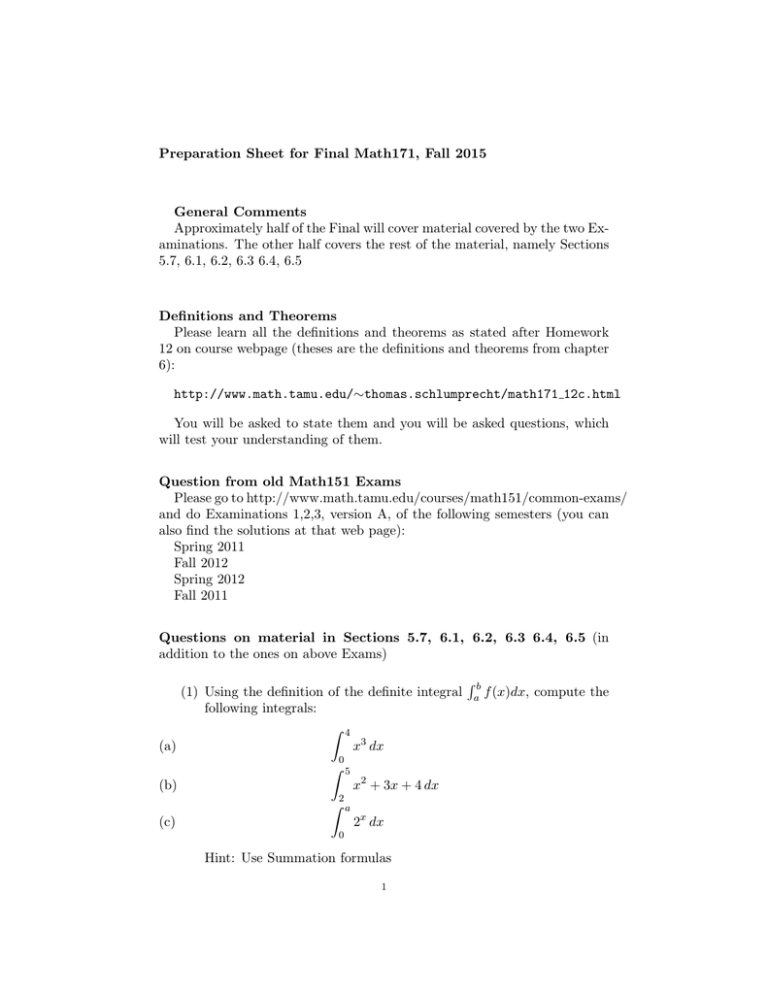
Preparation Sheet for Final Math171, Fall 2015 General Comments Approximately half of the Final will cover material covered by the two Examinations. The other half covers the rest of the material, namely Sections 5.7, 6.1, 6.2, 6.3 6.4, 6.5 Definitions and Theorems Please learn all the definitions and theorems as stated after Homework 12 on course webpage (theses are the definitions and theorems from chapter 6): http://www.math.tamu.edu/∼thomas.schlumprecht/math171 12c.html You will be asked to state them and you will be asked questions, which will test your understanding of them. Question from old Math151 Exams Please go to http://www.math.tamu.edu/courses/math151/common-exams/ and do Examinations 1,2,3, version A, of the following semesters (you can also find the solutions at that web page): Spring 2011 Fall 2012 Spring 2012 Fall 2011 Questions on material in Sections 5.7, 6.1, 6.2, 6.3 6.4, 6.5 (in addition to the ones on above Exams) (1) Using the definition of the definite integral following integrals: Z 4 (a) x3 dx 0 Z 5 (b) x2 + 3x + 4 dx 2 Z a (c) 2x dx 0 Hint: Use Summation formulas 1 Rb a f (x)dx, compute the 2 (2) Find d dx Z (a) Z cos x2 dx = d cos x2 dx = dx Z π d cos x2 dx = dx 0 Z π d cos x2 dx = 0 dx (b) (c) (d) (answers should not have an integral sign) (3) Compute 1 lim h→0 h Z h 2 e−x dx. 0 (4) Write the following integrals as limit of Riemann sums using left end points, right endpoints and mid points (do not compute them): Z 6 (a) tan(2x + 3) dx 3 Z 4 (b) x sin x2 dx 0 (5) Show that Z √ √ x 9 − x2 9 − x2 dx = − − arcsin + C. x2 x 3 (6) The acceleration of an object moving along a straight line is given by a(t) = (2t + 3)−3 (in m/sec2 ). The initial velocity is 4 m/sec. What is its velocity at t = 2 and and how far did it move during that time span? (7) An increasing functions f (x) on [0, 1] attains the following values: f (0) = .1 f (.1) = .2 f (.3) = 1 f (.5) = 1.2 f (.6) = 1.3 f (.8) = 1.6 f (1) = 2. R1 Find the best possible estimation of 0 f (x)dx from above and from below. How about if we do not assume that f (x) is increasing? 3 (8) Write as a definite integral: n X j3 n→∞ n4 lim (a) j=1 lim (b) n→∞ (c) lim n→∞ (d) lim n→∞ n X j=1 n X j=1 n X j=1 3+ 2j − 2 2 1 n n 2+4 j 3 1 n n ! jπ 2 2π jπ sin n n n (9) Compute (a) (b) (c) (d) (e) Z x2 d sin(t) dt dx 0 Z x d et dt dx −x Z x d tan t2 dt dx x3 Z x d 2 et dt dx −x Z x d t2 e dt −x dt 4 (10) Compute the following indefinite and definite integrals Z (a) x sin(x2 ) dx √ Z sin x √ (b) dx x Z π/3 (c) tan x dx 0 Z 3 3x2 − 1 (d) dx 3 2 2 (x − x) Z 1p (e) 1 − x2 dx −1 4 Z √ (f) 0 x dx 1 + 2x π/2 Z sin3 (x) dx (g) −π/2 Z (h) x p 2 + 4x2 dx 1 Z tan(x2 ) dx (i) Z1 tan(x) sec2 (x) dx √ Z cos( x) √ dx x Z π/2 2 x sin x dx 6 π/2 1 + x Z tan(x) dx (j) (k) (l) (m) (11) Find Z √ f 00 (x) dx where f (x) = x x3 . (12) Find the interval(s) on which Z x 1 + t + t2 dt, 1 + t2 0 is concave up/down. (13) Compute Z 1 4 |x2 + x − 6| dx. 5 (14) Compute Z e ln x dx x 1/e (15) Write without integral Z d a) sin(x2 ) dx = dx Z d b) sin(x2 ) dx = dx Z π d sin(x2 ) dx = c) dx 0 Z π d d) sin(x2 ) dx = dx 0

